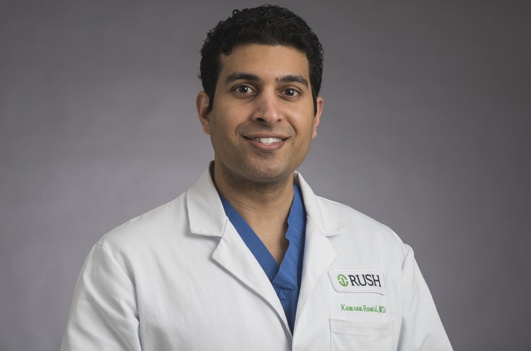(CHICAGO) – Orthopedic experts at Rush University Medical Center are the first in the Midwest to offer a new treatment using the first synthetic cartilage device approved by the FDA for patients suffering from painful arthritis at the base of the big toe. The condition, known as hallux rigidus, is the most common arthritic condition in the foot.
“Arthritic joint damage in the big toe can make standing or walking agonizing,” says Kamran Hamid, MD, a foot and ankle orthopedic surgeon at Rush. The condition affects one in 45 Americans over the age of 50, or about 2 million people. These numbers are expected to grow as the U.S. population ages.
In patients with osteoarthritis, which affects about 27 million Americans, the cartilage breaks down, causing pain and inflammation and limiting motion. Osteoarthritis can affect any joint, but occurs most often in knees, hips, hands and big toe. Unlike bone and other connective tissue, cartilage does not have the ability to repair itself.
When medication, braces, physical therapy, weight loss and activity restrictions do not work, the next treatment for hallux rigidus is usually fusion surgery. This procedure fuses the bones in the arthritic joint with plates and screws. While fusion surgery is effective for eliminating pain, it permanently prevents movement of the joint, hampering mobility.
Implant mimics natural cartilage
The first synthetic cartilage device approved by the FDA, the Cartiva Synthetic Cartilage Implant, replaces part of the damaged cartilage surface in the joint and provides improved mobility compared to the outcomes of traditional fusion surgery.
“Patients can begin walking on the foot much sooner,” said Hamid.
The implant device is made of biocompatible polymer and is designed to have physical properties similar to those of cartilage. It is similar to material used in contact lenses called hydrogel.
“It mimics natural cartilage and can achieve the same pain relief as surgery while retaining joint mobility,” Hamid says. “Your big toe is an important weight bearing joint and is as important as your hips, knees and hands.”
"In addition, synthetic cartilage implantation is a minimally invasive treatment that takes less operative time than a traditional fusion surgery,” Hamid continues. “There is no cast to wear, and patients can begin bearing full weight almost immediately.”
Two years of data from research studies on the Cartiva Synthetic Cartilage Implant showed that patients experienced a faster recovery and comparable pain relief to fusion patients.
Dr. Hamid and his team at Rush are the first to perform the new procedure in the Midwest.
Procedure returns patient to daily yoga routine
For 62-year-old Samuel Moylan from Elk Grove Village, Ill., the big toe pain he was suffering from was crippling.
“I’ve always been active all my life,” Moylan says. “I had a job that required physical strength and I had to be on my feet, so I exercised regularly about three times a week in order to do my job well and because I love living a healthy lifestyle. However, the toe pain became overwhelming to the point where I had to retire early.”
The big toe pain began several years ago and by 2013 became so painful that Moylan went to see a doctor, who recommended cortisone injections. After a couple of months, the shots stopped working, so he was given supartz injections also known as “joint juice” every few months. When the injections and a procedure did not help, Moylan realized that he might have to have fusion surgery.
“I was trying to avoid the surgery at all costs,” he says. “I am very active and love to exercise. Also, I practice yoga regularly, and the big toe is key for balance and stability. Fusion surgery could really affect my ability to practice yoga, which really was upsetting.”
In Sept. 2016, Moylan underwent the synthetic cartilage implant surgery by Dr. Hamid. He was already walking the next day in a protective boot. A week later, he was able to mow the lawn in work boots.
“I was back to practicing yoga in six weeks and am back to my workout schedule of yoga three times a week and weightlifting once a week,” he says.
Media contact:
Deb Song
(312) 942-0588
deb_song@rush.edu

